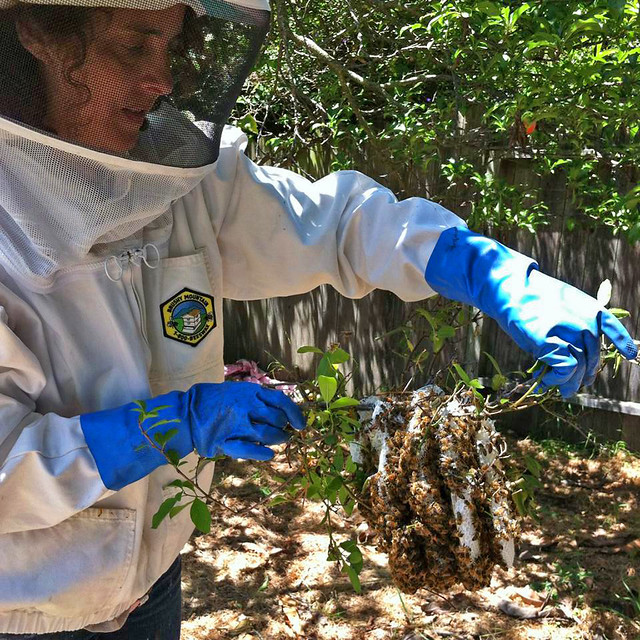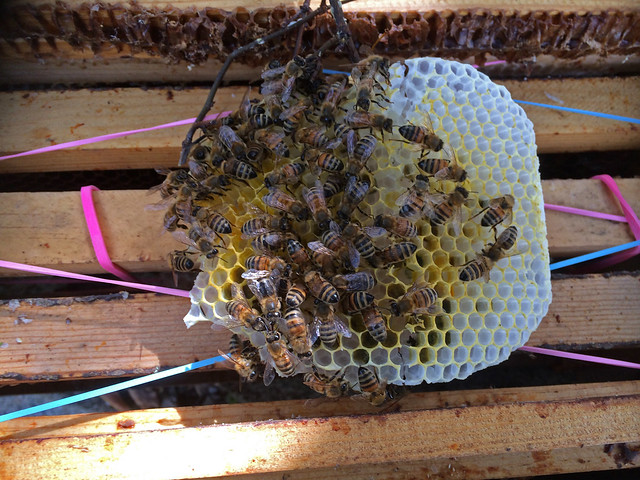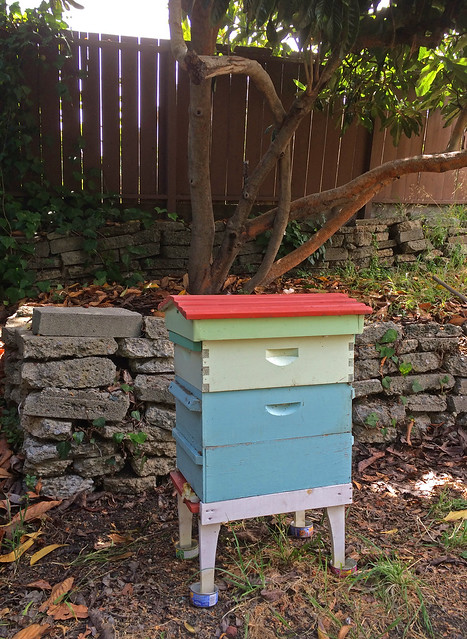An Update on Christine's Bees
...
A week ago, I helped my friend Christine relocate a colony of bees out of her lemon tree. We carefully moved the beautiful wax structure that the bees had built, and placed it into a hive.
My plan was to let the bees settle. Hopefully, they would accept the hive as their home. I wanted to disrupt the bees as little as possible, and encourage them to make a home in the hive.
On Saturday morning, I went by Christine's house to see how the bees were doing. Everything looked good. The bees were relaxed and un-aggressive. They had been collecting nectar and pollen, and the queen had been laying eggs.
So now, it was time to do a bit of housekeeping. If I left things alone, the bees would have continued to build wax comb, eventually filling the wooden hive boxes. However, for the well-being of the bees, I chose to ever-so-carefully pry apart the layers of wax comb, and attach them to movable frames. This way, each wax paddle can be removed from the hive for inspection. I'm told that non-inspectable hives are illegal under United States law, but I've never confirmed this fact.
I had interlaced large rubber bands, to form a flexible cradle for the bees' comb. I gently slid the bands over the bees, trying my best not to pinch them. I think I did well. No bees were crushed, and I was not stung.
There was a bit of distortion in some of the brood combs. I fear I may have injured some of the developing larval bees. I moved as slowly and carefully as I could, but there was no way of separating the paddles without applying a bit of force.
Here you can see developing baby bees. The queen is laying eggs, which develop into larval bees. At a certain stage in their development, the worker bees cover up the cells in which the bees are growing, and the developing creatures undergo a transformation from grub to actual honeybee. That beige-yellow color you see on the closed-up honeycomb encapsulates developing bees. That's a fantastic sign, meaning that the colony of bees is working together to produce new bees.
I can also tell by looking at this that the queen in this colony is fertile. The size of the honeycomb is linked to the gender of the bees developing inside of them. These cells contain developing female bees, which can only be produced by a fertile queen.
What a success! The bees are easy to work with. They've got a great location between a loquat, a lemon, and a plum tree. I am very pleased with how this colony of bees are doing.
I won't go back for a couple of weeks. The work I did this weekend was necessary, and also terribly disruptive, and I want the bees to have time to undo all the damage I did to their home.
I'm really happy that Christine is letting these bees live in her back yard. I think they're going to thrive. If you've ever wanted to keep bees, but didn't want all the responsibility, consider offering your yard to a local beekeeper. It can be a great arrangement, beneficial to all parties.
A week ago, I helped my friend Christine relocate a colony of bees out of her lemon tree. We carefully moved the beautiful wax structure that the bees had built, and placed it into a hive.
My plan was to let the bees settle. Hopefully, they would accept the hive as their home. I wanted to disrupt the bees as little as possible, and encourage them to make a home in the hive.
On Saturday morning, I went by Christine's house to see how the bees were doing. Everything looked good. The bees were relaxed and un-aggressive. They had been collecting nectar and pollen, and the queen had been laying eggs.
So now, it was time to do a bit of housekeeping. If I left things alone, the bees would have continued to build wax comb, eventually filling the wooden hive boxes. However, for the well-being of the bees, I chose to ever-so-carefully pry apart the layers of wax comb, and attach them to movable frames. This way, each wax paddle can be removed from the hive for inspection. I'm told that non-inspectable hives are illegal under United States law, but I've never confirmed this fact.
I had interlaced large rubber bands, to form a flexible cradle for the bees' comb. I gently slid the bands over the bees, trying my best not to pinch them. I think I did well. No bees were crushed, and I was not stung.
There was a bit of distortion in some of the brood combs. I fear I may have injured some of the developing larval bees. I moved as slowly and carefully as I could, but there was no way of separating the paddles without applying a bit of force.
Here you can see developing baby bees. The queen is laying eggs, which develop into larval bees. At a certain stage in their development, the worker bees cover up the cells in which the bees are growing, and the developing creatures undergo a transformation from grub to actual honeybee. That beige-yellow color you see on the closed-up honeycomb encapsulates developing bees. That's a fantastic sign, meaning that the colony of bees is working together to produce new bees.
I can also tell by looking at this that the queen in this colony is fertile. The size of the honeycomb is linked to the gender of the bees developing inside of them. These cells contain developing female bees, which can only be produced by a fertile queen.
What a success! The bees are easy to work with. They've got a great location between a loquat, a lemon, and a plum tree. I am very pleased with how this colony of bees are doing.
I won't go back for a couple of weeks. The work I did this weekend was necessary, and also terribly disruptive, and I want the bees to have time to undo all the damage I did to their home.
I'm really happy that Christine is letting these bees live in her back yard. I think they're going to thrive. If you've ever wanted to keep bees, but didn't want all the responsibility, consider offering your yard to a local beekeeper. It can be a great arrangement, beneficial to all parties.






Comments